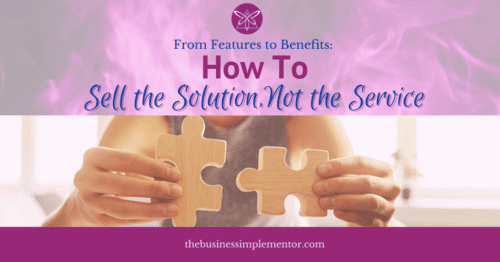This is Copywriting 101, and we all still keep getting it wrong.
From the latest product features to the most advanced technical specifications, it’s easy to get caught up in the details when writing copy for your services. But while features are certainly important, they’re not what ultimately convinces customers to buy. What matters is the benefits that your service provides.
In this article, we’ll explore why focusing on benefits beats listing features every time, and how you can use benefits to create more compelling marketing messages that connect with your target audience.
Research has shown that people often make purchasing decisions based on emotions rather than logic. They may initially be drawn to a product or service based on how it makes them feel, and then use rational thinking to justify their decision.
This is why it’s so important to focus on the benefits of your service rather than just listing its features. Benefits appeal to people’s emotions by showing them how your service can improve their lives or solve a problem they’re facing. By highlighting the benefits of your service, you can tap into the emotional aspects of buying and create a connection with your customers.
Once you’ve captured their hearts, you can then use logical arguments to reinforce their decision to buy. This is why benefits should be at the forefront of your marketing efforts, as they allow you to appeal to customers’ emotions and create a compelling reason for them to choose your service.
If there’s one thing that confuses and frustrates new (and even seasoned) copywriters it’s the not-always-obvious features and benefits.
We want to share all the great things about our service, so if you have a course for example, you might say things like:
- Self-study course
- Includes workbooks and live training
- Members’ only discounts
While these are all good points, they’re pretty bland. That’s because they’re features, not benefits. Features refer to the characteristics or attributes of a product or service. These are the factual details that describe what the product or service does or how it works.
They tell us about the program but not why we should buy it. On the other hand, benefits are the positive outcomes or results that customers get from using the product or service. These are the reasons why a customer would want to buy the product or service. Benefits are what satisfy the customer’s needs, desires, or goals.
Benefits tell us the “so what” of features.
“Self-study course.” So what? Why should your audience care?
- Because she’s busy and needs to work on her schedule, not yours.
- Because she’s already studied shorter, less comprehensive courses and needs more in-depth information.
- Because she prefers to learn on her own, not in a group.
“Includes workbooks and live training.” So what? What are the benefits of workbooks and live training?
- Your member can put what she learns into action with workbooks.
- She can get her specific questions answered during live training.
- She can work through complex issues with the help of the group.
As you can see, benefits go much further than simple attributes, such as length and format. They show your prospective client not only what’s in the program, but why the product is exactly right for her, at this specific moment in her life and career.
Features and benefits work together in sales copy as two halves of a statement, like this:
“A self-study course so you can learn at your own pace when it’s convenient for you.”
This powerful feature/benefit combo is often the basis for the bullet points you see in sales copy, and their format of them makes them easy to write, too.
Simply list all the features of your product, then for each one, ask yourself “Why?” Why should the reader care? But don’t stop there. Dig deeper to uncover “the why behind the why” and you’ll soon be crafting truly irresistible sales pages that convert far better than you expect.
In the above example, the why behind the why might be, “so you don’t have to spend family time on webinars that have been scheduled to benefit someone else.”
Now not only is your prospective client working at her own pace, but she’s also freeing up time to spend with her family. That’s a great benefit she won’t find with most courses.
It’s easy to list all the features of your product or coaching program, but far more difficult to uncover the benefits that will drive sales. When you truly understand the difference though, it will become easier, and your sales will reflect the change in your copy.
Understanding the difference between features and benefits is crucial for copywriting because it can significantly impact the effectiveness of your marketing message.
When writing copy, it’s important to focus on the benefits that the product or service provides to the customer, rather than simply listing the features.
Customers are more interested in how a product or service can improve their lives, rather than the technical details of how it works.
By emphasising the benefits, copywriters can create a more persuasive and emotionally compelling message that connects with the customer’s needs and desires. This can lead to higher conversion rates and increased sales.
Additionally, emphasising the benefits of a product or service can help to differentiate it from competitors in the market. While competitors may offer similar features, highlighting unique benefits can create a unique selling proposition and make the product or service stand out.
In short, understanding the difference between features and benefits is crucial for effective copywriting, as it helps to create a more persuasive and emotionally compelling message that resonates with customers and drives sales.
To identify the benefits of your services, you can start by considering the needs and desires of your target audience.
What problem or pain point does your service address?
How does it improve the lives of your customers?
What positive outcomes can they expect from using your service?
Here are some steps you can take to identify the benefits of your services:
- Identify your target audience: Understand who your customers are, what their needs and desires are, and what motivates them to buy your service.
- List the features of your service: Make a list of all the features of your service, such as what it does, how it works, and what it includes.
- Translate features into benefits: For each feature, think about how it benefits your customers. Ask yourself, “What’s in it for them?” For example, if your service includes 24/7 customer support, the benefit might be the peace of mind knowing that help is always available when they need it.
- Prioritise benefits: Rank the benefits in order of importance to your customers. This will help you focus your messaging on the most compelling benefits.
- Use customer feedback: Ask your current customers for feedback on how your service has improved their lives. Use their stories and testimonials in your marketing materials to highlight the real-world benefits of your service.
By following these steps, you can identify the benefits of your service and use them to create more effective marketing messages that resonate with your target audience.
Remember, customers, buy benefits, not features. So, it's essential to communicate how your service will improve their lives and solve their problems. Benefits are more important than features when writing copy for your services.
While features provide factual information about your service, benefits explain how your service can improve the lives of your customers. Customers are more interested in the benefits of a service because they want to know how it will solve their problems or fulfil their desires.
By emphasising the benefits, you can create a more compelling and emotionally resonant message that connects with your customers and motivates them to take action.
That being said, it’s still important to include some information about the features of your service. Features help to establish credibility and provide important information about what your service does and how it works.
However, the focus of your copy should be on the benefits of your service and how it will improve the lives of your customers.








